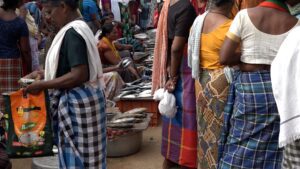Has it ever felt odd to see the word “sustainable” mashed up against the word “development?” One word implies forever, in perpetuity, while the next word implies growth, progress and expansion. Similar to “military intelligence” might “sustainable development” be an oxymoron?
In Saving Walden’s World, one of the protagonists, Santhi Rajasekhar, points out: “They’re always talking about development. Development. But with the development, we are losing our environment. Our planet, too. We know that the generations will be coming one by one. The planet needs to be here with all its resources.”

Have you ever taken a moment to contemplate the impact our personal or collective choices have on the planet’s health? If our commitment is to achieve environmental sustainability, and we begin to set measurable goals, do you think it is possible to avoid the trap Santhi puts so clearly? It’s a thought that lingers in the minds of many, especially in a world where challenges seem insurmountable and inequality and environmental degradation continue to loom. But amidst these uncertainties, a glimmer of hope emerges, a shared vision that unites nations, organizations, and individuals in a quest for a better tomorrow.
Sustainability has become a buzzword in today’s world, and for good reason. The growing population and rapid development have put a significant strain on the planet’s resources, making it essential to transition to restorative practices. The United Nations has identified 17 Sustainable Development Goals (SDGs) as a roadmap to a livable future, by 2030. In this article, we will explore these goals and discuss how individuals and organizations can take action to achieve them.
Saving Walden’s World ventures to three societies that are decades ahead in implementing the SDGs in quite novel ways. Ensuring the world works for all, including the planet and it’s millions of species, is no easy task, however, having examples can jumpstart the process.
Questions:
Find quotes from Santhi, Usha, Indira, TN Seema, Devika, Norma, Mavis, Leidy, Chavely, Vesna, Ziva, Gaja – see the TO THE END study guide for examples of placing quotes in amongst the text, and to make more visual – like a film.
Why the SDGs are Needed
With the global population expected to reach 9.7 billion by 2050, and 11 billion by 2100, there is an urgent need to address issues such as poverty, inequality, and environmental degradation. The United Nations has established the Sustainable Development Goals (SDGs) as a universal framework for recovering social and ecological health . While the SDGs offer a roadmap for action, progress towards these goals has been slow. Deputy Secretary Amina J. Mohammed, the women charged with overseeing the program has sounded the alarm. In fact, a recent report by the United Nations found that the world is falling short of meeting the SDGs, with progress hampered by factors such as climate change, inequality, and conflict.
Our film’s director, Jim Merkel, developed the concept of “Global Living,” in his book “Radical Simplicity,” to help us delve into the ways our individual choices carry a profound impact that extends far beyond our immediate surroundings. If we recognize the interconnectedness of our world, our actions as consumers and inhabitants of this planet might begin to transform.
At the heart of radical simplicity lies the recognition of our shared responsibility toward the Earth and its life forms, irrespective of geographical or cultural boundaries. It necessitates a shift in perspective, transcending national limitations and embracing a sense of global citizenship. By acknowledging the interdependence of our lives, we become aware that our choices reverberate throughout the world, affecting others both near and far.
Global living calls for conscientiously diminishing our ecological footprint, adopting sustainable alternatives, and minimizing waste. It implores us to consider the social and environmental ramifications of our choices, advocating for fair trade, championing workers’ rights, and advancing sustainable development.
It nurtures an appreciation for the richness of cultural diversity and fosters cross-cultural understanding. It encourages us to actively engage with diverse perspectives, embracing the wisdom and experiences of others. By dismantling barriers and challenging stereotypes, we construct bridges of understanding and empathy, facilitating harmonious coexistence.
“Radical Simplicity” propels global living beyond a mere concept, urging us to translate our understanding into purposeful action. It compels us to transcend our immediate desires and reflect upon the broader implications of our choices. It serves as a catalyst for active participation in forging a sustainable and equitable world, one where the well-being of all beings and the planet takes precedence.
As we examine our lifestyles our patterns of consumption can become mindful. By embarking on this transformative journey of global living, we can contribute to the creation of a more interconnected and compassionate world, where our choices reverberate positively across borders, cultures, and generations.


The SDGs were adopted by the United Nations in 2015 as part of the 2030 Agenda for Sustainable Development. The goals were developed through a consultative process involving governments, civil society, and the private sector, and are intended to be universal and applicable to all countries, regardless of their level of development.
The 17 SDGs are as follows:
Each of these goals is important in its own right, and together they represent a comprehensive framework for achieving sustainable development. The goals are designed to be interconnected, and achieving one goal can help to support progress towards others.
The Sustainable Development Goals are a continuation of the Millennium Development Goals (MDGs), which were set in 2000 and aimed to address extreme poverty and other global issues by 2015. The MDGs were successful in reducing poverty rates and improving access to education and healthcare in many parts of the world. However, there were still many challenges left to be addressed, and the United Nations recognized the need for a more comprehensive and sustainable approach to development.
In 2012, the United Nations Conference on Sustainable Development (Rio+20) marked a turning point in the global effort to achieve sustainable development. The conference highlighted the need for a new set of goals that would integrate economic, social, and environmental dimensions of sustainable development. Following this conference, a process was initiated to develop the Sustainable Development Goals (SDGs), which were officially adopted by the United Nations General Assembly in 2015.


The Sustainable Development Goals are significant because they provide a universal framework for countries, organizations, and individuals to work towards a more sustainable future. The goals are interconnected, and achieving one goal often requires progress in other areas as well. For example, ending poverty (Goal 1) is closely linked to improving access to education (Goal 4), healthcare (Goal 3), and economic growth (Goal 8).
The SDGs also recognize the importance of environmental sustainability and the need to protect our planet for future generations. The goals related to environmental sustainability (Goals 13-15) aim to combat climate change, preserve biodiversity, and promote sustainable use of natural resources.
While organizations play an essential role in achieving the SDGs, individuals can also make a significant contribution to sustainable development. Here are some ways individuals can help achieve the SDGs:
Organizations, including businesses and non-profit organizations, also have a crucial role to play in achieving the Sustainable Development Goals. Here are some ways organizations can contribute:
Align Business Practices with the SDGs: Organizations can align their business practices with the SDGs by setting goals and targets that address the challenges outlined in the goals. For example, a company may set a target to reduce its carbon footprint or increase the number of employees from underrepresented groups.
Collaborate with Other Organizations: Collaboration between organizations is essential for achieving the SDGs, as many of the goals require a collective effort. Organizations can collaborate with other businesses, non-profits, and governments to work towards the goals.
Implement Sustainable Practices: Organizations can implement sustainable practices in their operations to reduce their environmental impact and promote sustainable development. This can involve using renewable energy, reducing waste and emissions, and promoting sustainable production methods.
Support Community Development: Organizations can also contribute to community development by supporting initiatives that align with the SDGs. This can involve supporting education and training programs, investing in local infrastructure, and promoting economic development.
While the Sustainable Development Goals provide a roadmap for achieving sustainable development, progress towards these goals has been slow, and there are significant challenges to overcome. One of the primary challenges is a lack of political will and resources, particularly in developing countries. Additionally, addressing issues such as poverty, inequality, and environmental degradation requires significant changes to existing economic, social, and political systems, which can be difficult to achieve.
Education and awareness are also critical, as many individuals and organizations are still not fully aware of the SDGs and their importance. Finally, ensuring that progress towards the SDGs is equitable and inclusive requires collaboration and partnerships across all sectors, which can be challenging to achieve.
The Sustainable Development Goals offer a universal framework for achieving a more sustainable future for all. While achieving these goals requires the collective effort of governments, organizations, and individuals, individuals have an important role to play in making a difference. By educating ourselves, changing our consumption habits, and supporting sustainable businesses and organizations, we can all contribute to achieving the Sustainable Development Goals and creating a more sustainable future.
Copyright © 2024 Walden’s World Production – All rights Reserved | Designed by FerdaousWP